Friendly Societies Home | Affiliated Friendly Societies
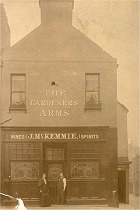
Rechabites and others - the Temperance friendly societies
In the early nineteenth century many friendly societies were strongly associated with individual pubs or drinking dens, which in many towns were often the only venues where a substantial body (of men) could meet. The association of society with venue could be so strong that Foresters, Gardeners, Carters and others were still remembered in some public house names at the end of the twentieth century. In fact, one strand of thought held that friendly societies arose directly from 'harmonious clubs' promoted at the end of the eighteenth century by the proprietors of public houses or inns themselves. These clubs, otherwise simply existing to facilitate drinking, organised welfare by 'passing the hat'. In time members paid a regular subscription in return for welfare protection. From these clubs developed the affiliated orders - Oddfellows, Buffaloes, Foresters, Shepherds, Druids and others.
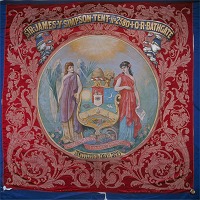
However, as ideas about temperance spread through the United Kingdom in the 19th century, some activists saw that there was an advantage in linking temperance with mutual aid. Subscriptions could be lower when the effects of alcohol were removed from the benefit equation.
The International Order of Rechabites take their name form an eponymous biblical tribe who were 'commanded to drink no wine' by their leader Jonadab son of Recab, and successfully resisted when tempted to do so. Taking their inspiration from the story, the founders of the Order opened their first 'Tent' or branch in Salford on 25 August 1835, in effect relaunching and subsuming an older Salford Temperance Burial Society. The first Scottish Tent was Caledonian No 73, which opened in January 1838. The 'Tents' spread so quickly that to co-ordinate the movement in Scotland an Edinburgh District was created by the end of that year.
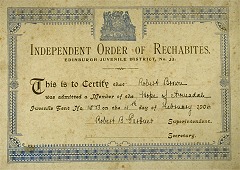
The Order bought whole-heartedly into the ethos of their Biblical namesakes and modelled their ritual, titles and structure along Biblical and tribal lines (as interpreted through the rituals of Freemasonry, with which many of the founders were familiar). Each Tent was ruled by a High Chief Ruler, assisted by a High Deputy Ruler, Corresponding Secretary, Sick and Tent Stewards, Inside and Outside Guardians, a 'Levite of the Tent' and a number of 'Elders'. Each had their own regalia and insignia; each had their own place and role in meetings of the Tent, particularly in ceremonies surrounding the induction of new members.

Some Rechabite Titles and Officers and their meanings
- HCR
- High Chief Ruler President
- HDR
- High Deputy Ruler Vice President
- CR
- Chief Ruler Branch Chairman
- PCR
- Past Chief Ruler Past branch Chairman
- DCR
- Deputy Chief Ruler Branch Vice Chairman
- CS
- Corresponding Secretary Clerk
- SS
- Sick Steward Sick Visitor
- TS
- Tent Steward Assistant at Meetings
- IG
- Inside Guardian Ceremonial officer
- OG
- Outside Guardian Ceremonial officer
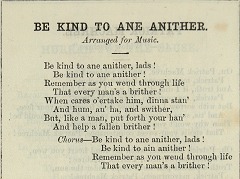
Titles and rituals were important because they afforded the membership in each Tent a structure or hierarchy with which they could identify and through which the committed could strive to progress. They gave the membership a means of identifying with the organisation, so counting themselves distinctive from competing organisations and other friendly societies. The Order was important because through membership the individual was part of a greater whole. By holding to their pledge, with the mutual support of the other members, all benefited.
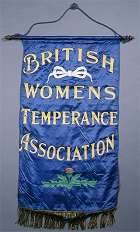
By the end of the 19th century many other bodies offered friendly society benefits in a temperance environment. The Independent Order of Good Templars arrived in Scotland from America in 1869. It was a total abstinence movement for the whole family. Other organisations with a branch structure simply propagated the temperance message in an atmosphere of mutual support. Hundreds of branches operated in the Edinburgh area, many associated with church congregations.
The British Women's Temperance Association was formed in England in 1876. In 1878 the Edinburgh branch of the BWTA was established and the next year Edinburgh became the Scottish headquarters of the movement. The initials SCU (Scottish Christian Union) were added to the title of the Association. The movement spread the message of total abstinence and the word of the gospel.
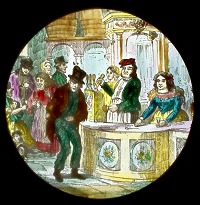
These others in the temperance movement included the British League of Juvenile Abstainers, founded in Edinburgh by John Hope. In 1875 the Edinburgh Band of Hope Union was formed, with the aim of having a Band of Hope attached to 'every congregation, mission hall, Sabbath School and Temperance Society'. By 1878 there were 35 Bands of Hope in Edinburgh. Aimed mainly at children, Bands of Hope provided entertainment with a message to their audience.
In this section:
Oddfellows | Oddfellows' Grand Lodges | Foresters | Shepherds | Gardeners | Rechabites
Friendly Societies Home | Affiliated Friendly Societies